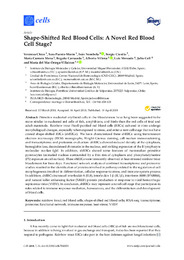Please use this identifier to cite or link to this item:
https://hdl.handle.net/11000/34448Full metadata record
| DC Field | Value | Language |
|---|---|---|
| dc.contributor.author | CHICO GRAS, VERONICA | - |
| dc.contributor.author | Puente Marin, Sara | - |
| dc.contributor.author | Nombela, Iván | - |
| dc.contributor.author | Ciordia, Sergio | - |
| dc.contributor.author | Mena, María Carmen | - |
| dc.contributor.author | Carracedo, Begoña | - |
| dc.contributor.author | Villena, Alberto | - |
| dc.contributor.author | Mercado, Luis | - |
| dc.contributor.author | coll, julio | - |
| dc.contributor.author | Ortega-Villaizan, Maria del Mar | - |
| dc.date.accessioned | 2025-01-14T12:55:14Z | - |
| dc.date.available | 2025-01-14T12:55:14Z | - |
| dc.date.created | 2018-04 | - |
| dc.identifier.citation | Cells 2018, 7, 31 | es_ES |
| dc.identifier.issn | 2073-4409 | - |
| dc.identifier.uri | https://hdl.handle.net/11000/34448 | - |
| dc.description.abstract | Primitive nucleated erythroid cells in the bloodstream have long been suggested to be more similar to nucleated red cells of fish, amphibians, and birds than the red cells of fetal and adult mammals. Rainbow trout Ficoll-purified red blood cells (RBCs) cultured in vitro undergo morphological changes, especially when exposed to stress, and enter a new cell stage that we have coined shape-shifted RBCs (shRBCs). We have characterized these shRBCs using transmission electron microscopy (TEM) micrographs, Wright–Giemsa staining, cell marker immunostaining, and transcriptomic and proteomic evaluation. shRBCs showed reduced density of the cytoplasm, hemoglobin loss, decondensed chromatin in the nucleus, and striking expression of the B lymphocyte molecular marker IgM. In addition, shRBCs shared some features of mammalian primitive pyrenocytes (extruded nucleus surrounded by a thin rim of cytoplasm and phosphatidylserine (PS) exposure on cell surface). These shRBCs were transiently observed in heat-stressed rainbow trout bloodstream for three days. Functional network analysis of combined transcriptomic and proteomic studies resulted in the identification of proteins involved in pathways related to the regulation of cell morphogenesis involved in differentiation, cellular response to stress, and immune system process. In addition, shRBCs increased interleukin 8 (IL8), interleukin 1 β (IL1β), interferon 8888 (IFN8888), and natural killer enhancing factor (NKEF) protein production in response to viral hemorrhagic septicemia virus (VHSV). In conclusion, shRBCs may represent a novel cell stage that participates in roles related to immune response mediation, homeostasis, and the differentiation and development of blood cells. | es_ES |
| dc.format | application/pdf | es_ES |
| dc.format.extent | 22 | es_ES |
| dc.language.iso | eng | es_ES |
| dc.publisher | MDPI | es_ES |
| dc.rights | info:eu-repo/semantics/openAccess | es_ES |
| dc.rights.uri | http://creativecommons.org/licenses/by-nc-nd/4.0/ | * |
| dc.subject | rainbow trout | es_ES |
| dc.subject | red blood cells | es_ES |
| dc.subject | shape-shifted red blood cells | es_ES |
| dc.subject | RNA-seq | es_ES |
| dc.subject | transcriptome | es_ES |
| dc.subject | proteome | es_ES |
| dc.subject | functional network | es_ES |
| dc.subject | immune response | es_ES |
| dc.subject | heat-stress | es_ES |
| dc.subject | VHSV | es_ES |
| dc.subject.other | CDU::6 - Ciencias aplicadas::60 - Cuestiones generales de las ciencias aplicadas | es_ES |
| dc.title | Shape-Shifted Red Blood Cells: A Novel Red Blood Cell Stage? | es_ES |
| dc.type | info:eu-repo/semantics/article | es_ES |
| dc.contributor.institute | Institutos de la UMH::Instituto de Investigación, Desarrollo e Innovación en Biotecnología Sanitaria de Elche | es_ES |
| dc.relation.publisherversion | https://doi.org/10.3390/cells7040031 | es_ES |

View/Open:
cells-07-00031-v2 (1).pdf
11,92 MB
Adobe PDF
Share:
.png)
